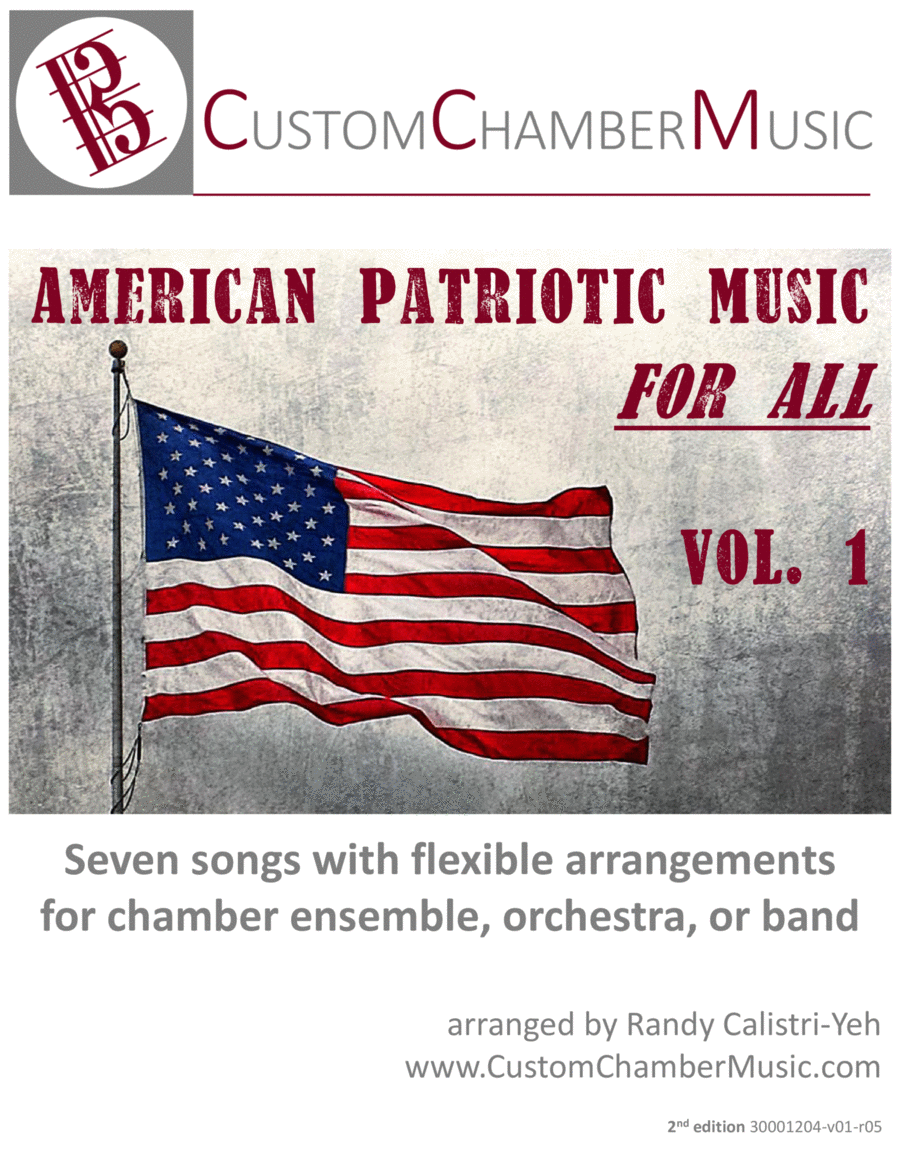Concert Band - Level 4 - Digital Download SKU: A0.742741 Composed by Various. Arranged by Randy Calistri-Yeh. Folk,Holiday,Patriotic,Traditional. Score and parts. 401 pages. Custom Chamber Music #350874. Published by Custom Chamber Music (A0.742741). 2nd edition - new and improved.Volume 1 of our Patriotic collection contains four classic patriotic tunes and three complete Sousa marches. Altogether this has seven songs and over 14 minutes of music that both you and your audience are sure to love. Each song is also available separately from the publisher link above.These arrangements can be played with anywhere from 3 to 7 parts, with a great deal of flexibility in instrumentation. This makes it ideal for bands of all types (school, community, or professional). This is one of the most versatile collections you'll ever use!The songs included in Volume 1 are:The Star-Spangled Banner (US National Anthem), by John Stafford Smith.America the Beautiful, by Samuel Ward.Battle Hymn of the Republic (Mine Eyes Have Seen the Glory).My Country, 'Tis of Thee (America, known as God Save the King/Queen in England).Stars and Stripes Forever, by John Philip Sousa.Washington Post March, by John Philip Sousa.Semper Fidelis, by John Philip Sousa.Each song is in its original key, so it is easy to combine these with your own choir or piano/organ parts. The difficulty level ranges from medium-easy to medium-advanced. The arrangements respect the original style of the composers while greatly expanding the instrument flexibility.This collection contains a full score, as well as individual parts in all the appropriate clefs and transpositions to support the following ensembles:Brass trio, quartet, quintet, and sextet.Woodwind trio, quartet, quintet, and sextet.String trio, quartet, quintet, and sextet.Clarinet trio, quartet, quintet, and sextet.Saxophone trio, quartet, and quintet.Mixed trio, quartet, quintet, and sextet (all with optional percussion).Wind ensemble, brass ensemble, string orchestra, full orchestra, and full band.The parts are described as follows:Part 1: Main melody. Piccolo, Flute, Oboe, Bb Clarinet, Soprano Saxophone, Bb Trumpet, Violin, Viola.Part 2: Main harmony, possibly some B-section melody. Bb Clarinet, Alto Clarinet, Alto Saxophone, Bb Trumpet, Violin, Viola.Part 3: Other harmony. Bb Clarinet, Alto/Bass Clarinet, Alto/Tenor Saxophone, French Horn, Bb Trumpet, Trombone, C/Bb Euphonium, Violin, Viola, Cello.Part 4: Main bass line. Bass Clarinet, Baritone Saxophone, Bassoon, Trombone, Bass Trombone, C/Bb Euphonium, Tuba, Cello, Bass.Part 5: Other harmony. Bass Clarinet, Baritone Saxophone, Bassoon, Trombone, Bass Trombone, C/Bb Euphonium, Tuba, Cello, Bass.Part 6: Main melody down an octave, with some additional notes. Bass Clarinet, Bassoon, French Horn, Trombone, C/Bb Euphonium, Cello, Bass.Part 7: Optional percussion (snare drum, bass drum, cymbal) that can be added to any of the above combinations, or skipped entirely.We recommend the following combinations:Trio: Parts 1, 2, 4 (#4 works better than #3 for trio).Quartet: Parts 1, 2, 3, 4.Quintet: Parts 1, 2, 3, 4, 5.Sextet: Parts 1, 2, 3, 4, 5, 6.Septet: Part 1, 2, 3, 4, 5, 6, 7.Be sure to also check out our three volumes of Christmas Carols for All!
